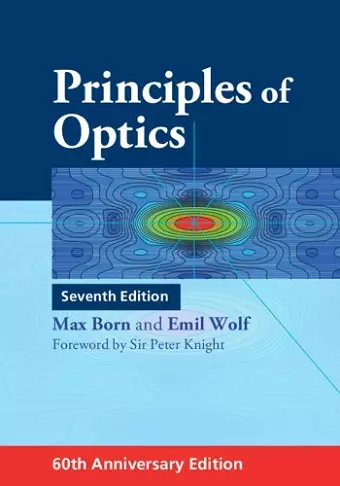Principles of Optics
60th Anniversary Edition
Max Born author Emil Wolf author
Format:Hardback
Publisher:Cambridge University Press
Published:19th Dec '19
Should be back in stock very soon

The 60th anniversary edition of this classic and unrivalled optics reference work includes a special foreword by Sir Peter Knight.
Principles of Optics is one of the classic science books of the twentieth century, and among the most influential books in optics ever published. To celebrate its 60th anniversary, the seventh expanded edition has been reprinted with a special foreword by Sir Peter Knight.Principles of Optics is one of the most highly cited and most influential physics books ever published, and one of the classic science books of the twentieth century. To celebrate the 60th anniversary of this remarkable book's first publication, the seventh expanded edition has been reprinted with a special foreword by Sir Peter Knight. The seventh edition was the first thorough revision and expansion of this definitive text. Amongst the material introduced in the seventh edition is a section on CAT scans, a chapter on scattering from inhomogeneous media, including an account of the principles of diffraction tomography, an account of scattering from periodic potentials, and a section on the so-called Rayleigh–Sommerfield diffraction theory. This expansive and timeless book continues to be invaluable to advanced undergraduates, graduate students and researchers working in all areas of optics.
'Today, the word 'optics' has been generalized to include all methods that understand, and exploit our understanding of, electromagnetic radiation, from radio waves to X-rays and gamma rays. Since the 1st edition published in 1959, one year before the advent of the laser, Principles of Optics stands out as the most influential, mathematically rigorous, and frequently cited treatment of classical optics. It spans topics as diverse as the geometric theory of aberrations to the rigorous treatment of diffraction theory and has served as the foundational reference work for many practitioners of optics, from physicists to optical to microwave engineers. As a University of Rochester undergraduate alumnus who was privileged to take Emil Wolf's electricity and magnetism course, I am especially delighted to see the 60th celebration of the 1st edition and the 20th anniversary of the 7th edition of this masterpiece.' Steven Chu, Stanford University, Nobel Prize in Physics 1997
'Since I have long had laboratories in two places, Göttingen and Heidelberg, I own not one but in fact two copies of this definitive compendium, for it should be on the shelves of any theorist and experimentalist working in optics.' Stefan W. Hell, Max Planck Institute for Biophysical Chemistry, Göttingen, and Max Planck Institute for Medical Research, Heidelberg, Nobel Prize in Chemistry 2014
'The anniversary issue of Born and Wolf invites reflection on how important this classic has been and continues to be. I learned optics in the last century, at the beginning of the laser revolution that breathed exciting and vibrant new life into what had become a crusty old subject. The optics I learned as a student had an antique, nineteenth-century feel. The optics I confronted as a researcher was explosive in its modernity, with Born and Wolf as the guidebook. Today, no optics practitioner's bookshelf is complete without Born and Wolf. For answers in classical optics, this is the first stop.' William D. Phillips, National Institute of Standards and Technology, and University of Maryland, Nobel Prize in Physics 1997
'I fondly remember Emil Wolf's genuine kindness. For example, he offered me a ride in a snow storm without recognizing that I was a student walking to his class. I wouldn't be without Principles of Optics in my office. So many times I have used it to better understand an optics concept that I am either teaching or using in my own research.' Donna Strickland, University of Waterloo, Nobel Prize in Physics 2018
'The book is really a graduate-level textbook, starting with the electromagnetic field description of optics, and ending with a chapter on the optics of metals and crystals. But undergraduates, too, may gain insight, for example from the discussion of image-forming instruments. Also noteworthy are the 12 appendixes, which add great utility to the volume. This jewel of 20th-century physical science belongs on every scientist's book shelf.' J. Lambropoulos, Choice
'The strength of the book is the mathematical lucidity derived from Born's extremely rigorous mathematical upbringing together with the then up-to-date ideas from Wolf … it has supported and influenced the four Nobel laureates whose plaudits cover the rear dust cover, and Sir Peter Knight (once editor of these reviews), who has written an extensive and enlightening introduction. It is still a hugely relevant resource which new researchers should be using as diligently as were their predecessors of nearly two generations ago.' R. S. Shorter, Contemporary Physics
ISBN: 9781108477437
Dimensions: 255mm x 182mm x 39mm
Weight: 1710g
992 pages
7th Revised edition